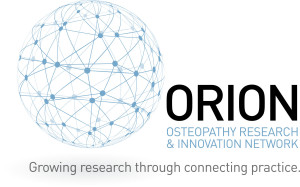What was the Catalyst for the ORION Project?
ORION is about starting from the grass roots of osteopathy. It’s not an experimental design written by a researcher. It’s about collecting data that aligns with day-to-day clinical practice.
The research will answer questions like:
- What happens in osteopathy in Australia?
- What is insightful and important in terms of evidence base within osteopathy?
- We want to discover what is happening in osteopathy practice:
- which treatments are used,
- what experiences patients and osteopaths have,
- what types of patients are being treated,
- what their outcomes are, and
- what practitioners do within in each consultation.
Why is this Research so Important to Osteopathy?
 This is perhaps even more important for a profession such as osteopathy that is keen to develop a closer relationship within healthcare and further establish a mainstream position. Health research can often appear to address issues not adequately grounded in, or reflecting grassroots practice, and what is essential is that emerging osteopathy research be reflective of, and provide benefit for, practitioners and patients. Without such information Osteopathy Australia is fighting with one arm tied behind our back.
This is perhaps even more important for a profession such as osteopathy that is keen to develop a closer relationship within healthcare and further establish a mainstream position. Health research can often appear to address issues not adequately grounded in, or reflecting grassroots practice, and what is essential is that emerging osteopathy research be reflective of, and provide benefit for, practitioners and patients. Without such information Osteopathy Australia is fighting with one arm tied behind our back.
ORION is not just about the next few years; the research will allow us to set up a platform the profession can build on for many years. It is also an opportunity for osteopaths, students and academics to be a part of a significant, empirical-based research project.
How can I be Involved?
What does the Research Project Involve?
 First we’ll conduct a national survey of osteopaths to gain insight into their behaviours, approaches, and day-to-day practice. The second phase involves looking at more detailed questions about practice, as well as examining patient experience and outcomes. ORION PBRN really comes down to the participation of osteopaths. We need as many participants as possible to help us make the study reliable and valuable to the profession. It’s an exciting way for osteopaths to be empowered within their profession, while being part of a significant research initiative to help develop an evidence-base.
First we’ll conduct a national survey of osteopaths to gain insight into their behaviours, approaches, and day-to-day practice. The second phase involves looking at more detailed questions about practice, as well as examining patient experience and outcomes. ORION PBRN really comes down to the participation of osteopaths. We need as many participants as possible to help us make the study reliable and valuable to the profession. It’s an exciting way for osteopaths to be empowered within their profession, while being part of a significant research initiative to help develop an evidence-base.What does ORION Project Aim to Achieve?
 ORION will help develop a sustainable research culture and evidence-base that is directly relevant to, and reflects, the concerns and practice of osteopaths. Rather than just being a project that comes and goes, we’re hoping to establish a platform that the profession and osteopathic academics (current and future) can build on, and develop an advanced and co-ordinated approach. The project is about mapping practice and underpinning practice with evidence.
ORION will help develop a sustainable research culture and evidence-base that is directly relevant to, and reflects, the concerns and practice of osteopaths. Rather than just being a project that comes and goes, we’re hoping to establish a platform that the profession and osteopathic academics (current and future) can build on, and develop an advanced and co-ordinated approach. The project is about mapping practice and underpinning practice with evidence.
While Osteopathy Australia and osteopaths will have ample opportunity to provide input to the study (this is a vital feature to ensure the research is relevant to practice) the independence of the research team is also important to ensure the credibility and reliability of findings.
How will the Project Benefit Osteopathy Study and Tertiary Education?
 The more we can create an evidence-informed practice, the more we can help university students garner real knowledge about their chosen profession. This project will not only give insight into clinical techniques, but also provide insights to help students engage with research, to alert them to the importance of research, plus produce empirical data to help them inform their own practice.
The more we can create an evidence-informed practice, the more we can help university students garner real knowledge about their chosen profession. This project will not only give insight into clinical techniques, but also provide insights to help students engage with research, to alert them to the importance of research, plus produce empirical data to help them inform their own practice.
ORION can also ask direct questions about osteopathy education. For instance, a possible sub-study could look at new graduates and the transition from university to private practice. Studies like these would be relevant to many other professions, not just osteopathy.
What Associated Opportunities will ORION Create for Osteopathy Moving Forward?

It’s also a great opportunity for PhD students to ‘nest’ their PhD project within the existing ORION Project via sub-studies. This collaboration with PhD students is another way ORION will help develop research capacity building within osteopathy. The enrolment of Such ‘nested’ PhDs can be based within any University as the overall aim is to create a broad and sustainable osteopathic research culture across Australia and institutions.
